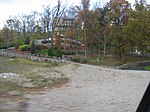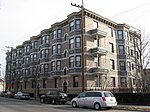St. Ursula Academy (Cincinnati, Ohio)
1910 establishments in OhioCatholic secondary schools in OhioCincinnati Bearcats basketball venuesEducational institutions established in 1910Girls' schools in Ohio ... and 5 more
Greater Catholic LeagueHigh schools in Hamilton County, OhioPrivate schools in CincinnatiRoman Catholic Archdiocese of CincinnatiUrsuline schools
St. Ursula Academy, located in the East Walnut Hills neighborhood of Cincinnati, Ohio, is a Catholic college-preparatory high school for young women that offers an intensive four-year program in the fields of English, mathematics, science, social studies, French, Spanish, Latin, and religion. An entrance test is required of all prospective freshmen students. Academic scholarships are also based on the results of this test. The school's Educational Services Program (ESP) assists girls with learning disabilities.
Excerpt from the Wikipedia article St. Ursula Academy (Cincinnati, Ohio) (License: CC BY-SA 3.0, Authors).St. Ursula Academy (Cincinnati, Ohio)
William Howard Taft Road, Cincinnati East Walnut Hills
Geographical coordinates (GPS) Address External links Nearby Places Show on map
Geographical coordinates (GPS)
| Latitude | Longitude |
|---|---|
| N 39.124722222222 ° | E -84.481666666667 ° |
Address
Saint Ursula Academy
William Howard Taft Road
45206 Cincinnati, East Walnut Hills
Ohio, United States
Open on Google Maps








